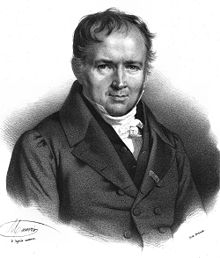
Back معادلة بواسون Arabic Ураўненне Пуасона Byelorussian Уравнение на Поасон Bulgarian Equació de Poisson Catalan Poissonova rovnice Czech Poisson-ligning Danish Poisson-Gleichung German Εξίσωση Πουασόν Greek Ecuación de Poisson Spanish Poissoni võrrand Estonian

Poisson's equation is an elliptic partial differential equation of broad utility in theoretical physics. For example, the solution to Poisson's equation is the potential field caused by a given electric charge or mass density distribution; with the potential field known, one can then calculate the corresponding electrostatic or gravitational (force) field. It is a generalization of Laplace's equation, which is also frequently seen in physics. The equation is named after French mathematician and physicist Siméon Denis Poisson who published it in 1823.[1][2]
- ^ Jackson, Julia A.; Mehl, James P.; Neuendorf, Klaus K. E., eds. (2005), Glossary of Geology, American Geological Institute, Springer, p. 503, ISBN 9780922152766
- ^ Poisson (1823). "Mémoire sur la théorie du magnétisme en mouvement" [Memoir on the theory of magnetism in motion]. Mémoires de l'Académie Royale des Sciences de l'Institut de France (in French). 6: 441–570. From p. 463: "Donc, d'après ce qui précède, nous aurons enfin: selon que le point M sera situé en dehors, à la surface ou en dedans du volume que l'on considère." (Thus, according to what preceded, we will finally have: depending on whether the point M is located outside, on the surface of, or inside the volume that one is considering.) V is defined (p. 462) as where, in the case of electrostatics, the integral is performed over the volume of the charged body, the coordinates of points that are inside or on the volume of the charged body are denoted by , is a given function of and in electrostatics, would be a measure of charge density, and is defined as the length of a radius extending from the point M to a point that lies inside or on the charged body. The coordinates of the point M are denoted by and denotes the value of (the charge density) at M.







